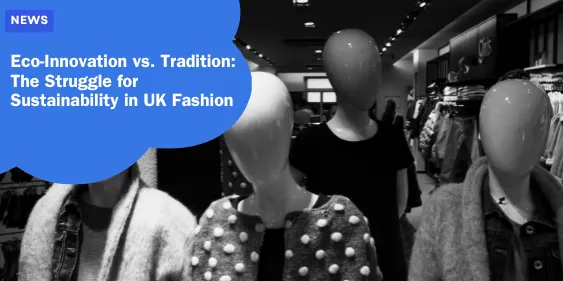Eco-Innovation vs. Tradition: The Struggle for Sustainability in UK Fashion

The Current Landscape of British Fashion Sustainability
The British fashion industry is facing a significant challenge when it comes to sustainability.
Recent statistics reveal that the sector is lagging behind in its environmental efforts. Alarmingly, only 3.4% of members of the British Fashion Council (BFC) have set emission reduction targets that align with the Paris Agreement.
In stark contrast, 44% of all UK companies have established structured plans for reducing their carbon footprints.
This disparity highlights a considerable gap in the industry’s commitment to sustainability.
The Dual Impact of Fast Fashion and Luxury Brands
Both fast fashion and luxury segments contribute significantly to environmental degradation.
These sectors often prioritize profit over environmental responsibility, creating substantial obstacles to the adoption of sustainable practices.
Why does this gap persist?
Profit Over Planet: The Driving Force
The fashion industry is entrenched in a profit-driven mindset, often at the expense of environmental stewardship.
Many brands continue to favor traditional, less eco-friendly materials due to concerns about the financial risks associated with transitioning to sustainable alternatives.
A Call for Systemic Change
A major transformation is essential. Strategies such as tax incentives for eco-friendly brands and the implementation of stricter sustainability standards at fashion events could drive meaningful change.
Government intervention is critical to enhance the effectiveness of these initiatives.
The urgency of addressing sustainability in British fashion is undeniable. It involves not only individual brands but also systemic change, which will be explored further in the following sections.
Barriers to Embracing Sustainable Practices
Profit-Driven Priorities
The focus on financial gain rather than climate action remains a significant barrier within the British fashion industry.
Despite the well-documented environmental impact of fashion, many brands maintain a “business-as-usual” approach, hindering necessary reforms.
The low percentage of BFC members adhering to Paris Agreement emission targets underscores this lack of commitment.
Resistance to Eco-Friendly Materials
The industry’s reluctance to adopt new, eco-friendly materials is another critical barrier.
Innovations such as plant-based leather offer promising alternatives to traditional, carbon-intensive materials.
Yet, adoption remains slow, largely due to fear of the unknown and an attachment to conventional methods.
This reluctance is detrimental, given that fossil fuel-based and animal-derived materials account for approximately 38% of the industry’s total emissions.
Insufficient Incentives for Climate Action
The scarcity of incentives for brands to address climate change head-on adds to the challenges.
Currently, there are minimal rewards or penalties to drive companies toward greener practices.
Experts suggest that tax incentives for climate-conscious brands could be a powerful motivator.
Additionally, adopting stricter sustainability standards, similar to those enforced by Copenhagen Fashion Week, could encourage the industry to embrace more eco-friendly practices.
The British fashion industry’s inertia necessitates innovative solutions and a collective effort from both government and consumers to foster a more sustainable future.
By making conscious choices today, we can pave the way for a more environmentally responsible industry tomorrow.
The Environmental Impact of Traditional Materials
Material Production and Its Emissions
Material production within the British fashion industry is a major contributor to environmental degradation, responsible for 38% of the sector’s total emissions.
Traditional materials like virgin leather, wool, and synthetic fabrics derived from fossil fuels dominate the market, driving these high emission levels.
Addressing Fossil Fuel-Based and Animal-Derived Materials
The fashion industry urgently needs to address the use of fossil fuel-based and animal-derived materials.
Although alternatives are available, the industry remains anchored in established practices due to misinformation and a lack of strong incentives to transition.
For instance, methane-intensive materials such as leather, wool, and cashmere contribute significantly to greenhouse gas emissions.
Misconceptions and the Path Forward
Confusion about the environmental effects of materials sourced from animals continues.
The association of luxury and quality with these materials often overshadows their environmental costs. However, innovative solutions are emerging.
Brands like Ganni have demonstrated success by eliminating virgin leather from their collections, highlighting the potential of next-generation bio-materials such as plant-based leathers.
To lessen the effects of traditional materials, brands should incorporate new and environmentally friendly fabrics.
By reevaluating historical norms and adopting forward-thinking material choices, the industry can make significant strides in reducing its carbon footprint and environmental impact.
Embracing Innovative Solutions and Success Stories
Next-Gen Bio Materials
The fashion industry’s wasteful practices have spurred a wave of innovation, particularly in the realm of next-generation bio-materials.
Plant-based leather alternatives, derived from sources such as cactus, mushrooms, and pineapple leaves, offer a promising way to reduce the industry’s carbon footprint.
These materials minimize reliance on harmful fossil fuel-based products and avoid the significant environmental impacts associated with animal-derived materials like leather.
Ganni’s Success Story
A notable example of embracing eco-friendly materials is the Danish brand, Ganni.
By phasing out virgin leather and adopting recycled and alternative materials, Ganni has significantly reduced its carbon emissions.
This success story proves that sustainable practices can be integrated without compromising brand identity or product quality.
The Need for Creativity and Innovation
The fashion industry needs more creativity and innovation in material choices.
While traditional materials like leather and wool are well-established, they contribute heavily to environmental degradation.
Embracing new materials requires a shift in mindset and a willingness to experiment.
Designers and brands must look beyond conventional options, driving change through innovation and creativity.
Proposed Strategies for Enhancing Sustainability
Tax Incentives for Eco-Conscious Brands
To promote sustainable practices in the fashion industry, tax incentives can act as a powerful motivator.
Brands that achieve significant emission reductions and adopt eco-friendly materials should be rewarded with tax breaks.
This financial relief can offset the higher initial costs associated with sustainable practices and innovative materials, acting as an economic incentive for brands to adopt greener practices.
Stricter Sustainability Standards for Fashion Events
Fashion weeks are influential events that set trends and impact industry practices.
Introducing more rigorous sustainability standards at these events can demonstrate a strong dedication to climate action.
For example, Copenhagen Fashion Week has set a precedent by mandating that brands meet certain sustainability requirements in order to take part.
If London Fashion Week adopted similar standards, it could drive significant change in the industry.
Such measures could include requirements for using recycled materials, fair labor practices, and transparent supply chains.
These standards can encourage brands to move away from harmful traditional methods, fostering creativity and innovation in sustainable fashion.
The Role of Consumer Awareness and Industry Accountability
Grassroots Movements and Individual Actions
Momentum for a more sustainable fashion industry is growing from grassroots movements and individual actions.
Consumers are becoming increasingly aware of the environmental impact of their shopping choices, driving demand for transparency and ethical practices.
Platforms like Fashion Revolution are instrumental in promoting this awareness and pressuring brands to disclose their sustainability efforts.
The Necessity for Industry-Wide Changes
While individual actions are commendable, they are insufficient to drive the comprehensive changes needed for sustainability.
Industry-wide shifts are essential.
Many brands continue to prioritize profit over environmental responsibility, which impedes the adoption of innovative, eco-friendly materials.
Both fast fashion and luxury brands must commit to significant, large-scale changes to make substantial progress toward sustainability.
The Importance of Transparency and Accountability
Transparency in the fashion sector is crucial. Consumers deserve to know the environmental and social impacts of their purchases. Brands that disclose their sustainability targets and progress build trust and accountability.
This transparency enables consumers to make informed choices, further driving demand for sustainable products.
Accountability is also essential. Without mechanisms to hold companies accountable, meaningful change remains elusive.
Measures such as penalties for non-compliance and incentives for meeting climate goals could be effective.
Tax cuts for brands that achieve their climate targets and sustainability standards for fashion events, similar to those at Copenhagen Fashion Week, could reinforce accountability.
In conclusion, while the role of consumer awareness and industry accountability is critical in driving sustainable practices in British fashion, true progress will require a concerted effort from both consumers and the industry.
The journey toward a cleaner, more transparent fashion industry is just beginning, and the upcoming steps will be pivotal in shaping its future.






